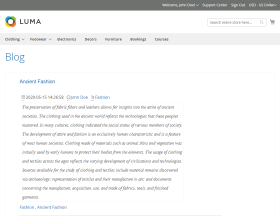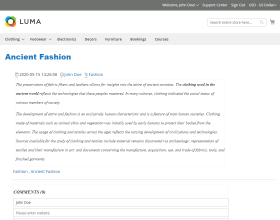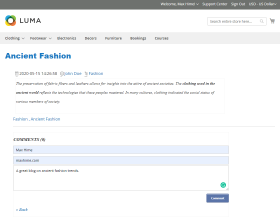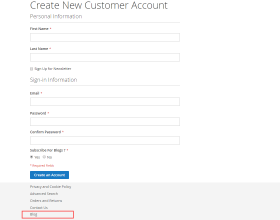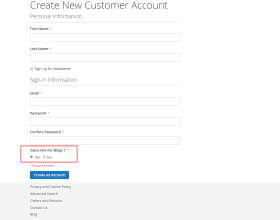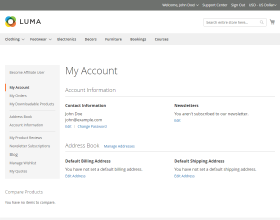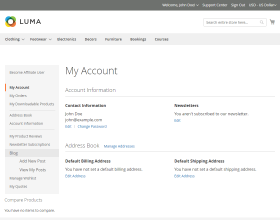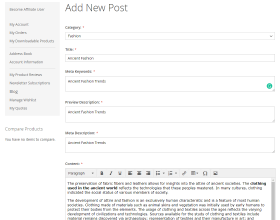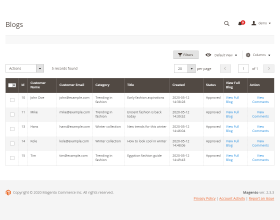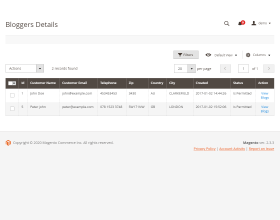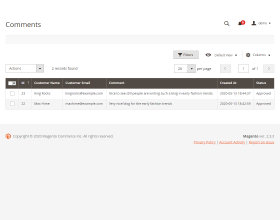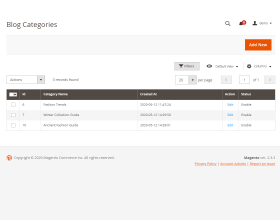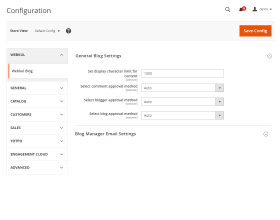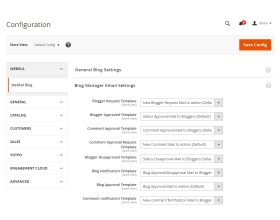
Top Selling Extension Winner
2 times in a row
Magento 2 Blog Extension
Magento 2 Blog Extension allows customers to publish blog posts and articles on the web store and also can manage the blog posts
- Each customer can see the blog by visiting the blog page.
- Any logged-in user can comment on any post of the customer.
- Multiple types of email notifications are sent to the admin and customer.
- A user can subscribe to blogs at the time of registration or after registration.
- Description
- Reviews
- FAQ
- Customers ()
- Specifications
- Cloud Hosting
- Changelog
Magento 2 Blog Extension enables the Customers to add their posts in the blog form in the Magento 2 Webstore. The Customer can also edit or delete the post. The store owner can permit or restrict any customer to write blogs.
The store owner can fully manage blogs i.e store owner can approve/ reject or delete any blog or its comments. The Magento 2 Blog Extension will enhance the feature of adding blogs to your store. It will help to create a strong relationship between the store and the customers.
Highlighted Features of Magento 2 Blog Extension
Blog Subscription
A user can subscribe to the blog at the time of registration and later on to write blogs.
Multiple Categories
The admin can create multiple categories for the bogs and the customer can use them for their blog.
Complete Blog Management
A customer can write a new blog and can edit or delete their existing blog using the Magento 2 blog extension.
Comments Moderation
If a comment is inappropriate then it can be unapproved or can be deleted by the admin.
Guest User Comment
A guest user can also make comments on the blog by just providing their mail address.
SEO Optimization
A user can add Meta Descriptions, Meta Keywords, and Tags for SEO optimization of a blog.
Email Notification
The admin and the user will be notified by email notifications for different actions.
Blogger Management
The admin can manage the bloggers as well and can allow or restrict a blogger accordingly.
Why Do We Need Magento 2 Blog Extension?
Nowadays, there are so many eCommerce websites available on the internet and it is getting difficult to get noticed by potential customers. Offering wonderful products at the best price is always not enough for an eCommerce website to generate traffic. Hence, business owners need to consider other ways as well to get their brand or company noticed by the consumers.
Adding a blog to your eCommerce website is a relatively easy way to boost your online profile, generate traffic for your business, increase brand awareness, and establish online authority. It will establish a direct line of communication with your customers, and keep up to date with changes and trends on the consumer side.
A blog on the eCommerce website is a perfect place to make announcements as well. Here, you can post the latest news and updates for any product, your most Frequently Asked Questions, seasonal promotions, or anything new about your company you would like to share.
A blog on the eCommerce website can create a community of users if they can also make their contributions. You need not worry about spamming or poor content, as it can be easily moderated.
Module Configuration
After installing the admin needs to the blog manager module configuration. The following options are available:
- Set the maximum display character limit.
- Select the comment display method - auto/manual.
- New blogger approval method - auto/manual.
- Approve a new blog - auto/manual.

Manage Blogs
The admin can view the list of blogs created by the users from the back end. The admin can view the customer name, email, blog title, and date created. The following options are available:
- Approve/reject/delete blogs.
- View comments posted on blogs.
- Approve/reject/delete comments.
- Find a blog or a comment using filters.

Manage Bloggers
Once a user subscribes to blogs, it can create blogs on the store. The admin can then view the bloggers' details from the back end. The admin can view the customer's name, email, city, country, zip code, telephone, and ID.
- Change status - permitted/not permitted.
- View the bloggers list with details.
- Link to view all the blogs of a user.

Blog Categories
The admin can create categories for the blogs. All the blogs are organized according to categories.
- Enable/disable/delete the category.
- The users can select a category.
- Edit category name.

Add Blog Post
The logged-in users need to subscribe to blogs to create a blog. After subscribing the users can add, edit or delete blog posts from the front end.
- Select a blog category.
- Enter the title.
- Meta keywords and description.
- WYSIWYG content editor.
- Add any tags to the blog post.
- Insert an image, video, or URL link.

Blogs Page
A separate blog page is there in the store. Any user can visit the blog page and view the blogs & comments. All users can share their views in the comments.
- Separate blogs page.
- Guest users can view blog posts and add comments.
- Add the URL link with the comment.
- Search blogs using tags, categories, and bloggers.

Features List of Magento 2 Blog Extension
- The store owner can give permission or restrict the customer to write the blog.
- The store owner can set the limit of words to be displayed on a particular blog on the List view page of blogs.
- The store owner can add any number of blog categories.
- A user can subscribe to blogs at the time of registration or after registration.
- The permitted customer can add the blog.
- The permitted customer can edit or delete their own blog.
- Store owners can fully manage the blogs and their comments by approving/un-approving or by deleting them.
- By using magento 2 blog extension customers can write/update their posts on the blog page.
- Proper blog management like adding/editing/deleting from the customer's account.
- Admin can manage all blogs and their comments.
- Admin can delete any blog.
- Admin can view all blogs at once as well as blogs by particular users.
- Admin can perform approved/reject/delete action for a particular blog's comment.
- Admin also provides permission to customers for adding posts on the blog.
- Categories can be created by the admin only.
- Admin can view, enable, disable, and delete the categories.
- There are two modes for posting comments i.e. Auto and Manual.
- In auto mode, the comment is displayed as soon as it is posted.
- In manual mode, the comment is displayed only after getting approved by the admin.
- Admin receives an email when a comment is added in manual mode.
- The user receives an email at comment approval.
- When a new comment is made, an e-mail is sent to the blogger who wrote that blog.
- There are two modes for subscribing to blogs i.e. Auto and Manual.
- In auto mode, the customer is approved as soon as he subscribes to blogs.
- In manual mode, the customer needs to get approved by the admin.
- In manual mode, an e-mail is sent to the admin from the customer who requests the blog.
- Admin receives an email when a customer subscribes to blogs in manual mode.
- A user receives an email when he is permitted for adding posts on the blog in manual mode.
- The guest users can view the blog and can add comments as well.
- Bloggers can add meta keywords and meta descriptions
- Blogger can set Preview Content for showing on the list.
Magento 2 Blog Extension Support
For any query or issue please create a support ticket here http://webkul.uvdesk.com/. You may also check our quality Magento 2 Extensions.
Specifications
Frequently Asked Questions
Move to Cloud Today
AWS Free tier hosting for one year by amazon web services, for more details please visit AWS Free Tier.
GCP Free tier hosting for one year with 300 credit points by google cloud platform, for more details please visit GCP Free Tier.
Azure free tier hosting for one year with 25+ always free services, for more details please visit Azure Free Tier.
In our default configuration we will provide tremendous configuration for your eCommerce Website which is fast to load and response.
Default Configuration Details of Server
- 1 GB RAM
- 1 Core Processor
- 30 GB Hard Disk
- DB with 1 GB RAM and 1 Core Processor
* Server Configuration may vary as per application requirements.
Want to know more how exactly we are going to power up your eCommerce Website with Cloud to fasten up your store. Please visit the Cloudkul Services.
Get Started with Cloud- + Features
- - Bugs
- + Compatible with magento version 2.4.x
- + Compatible with Magento version 2.3.x
- + Some issue fixed
- + Compatible with Magento version 2.3.x
- + Varnish supporting.
- + Composer.json issue fixed.
- + Compatible with Magento version 2.2.x
- - Email issue fixed.
- + By using this module customer can write/update his posts on the blog.
- + Proper blog management like add/edit/delete from the customer's account.
- + Each customer can see the blog by visiting the blog page.
- + Any logged in user can comment on any post of the customer.
- + Admin can manage all blogs and it’s comments.
- + Admin can delete any blog.
- + Admin can view all blogs at once as well as blogs by particular users.
- + Admin can perform approved/unapproved/delete action for a particular blog's comment.
- + Admin also provides permission to customers for adding posts on the blog.
- + Categories can be created by admin only.
- + Admin can view, enable, disable, and delete the categories.
- + There are two modes for posting comments i.e. Auto and Manual.
- + In auto mode the comment is displayed as soon as it is posted.
- + In manual mode the comment is displayed only after getting approved by admin.
- + Admin receives Email when a comment is added in manual mode.
- + User receives Email at comment approval.
- + When a new comment is made, an e-mail is sent to the blogger who wrote that blog.
- + Users can subscribe to blogs at the time of registration or after registration.
- + There are two modes for subscribing blogs i.e. Auto and Manual.
- + In auto mode the customer is approved as soon as he subscribes for blogs.
- + In manual mode the customer needs to get approved by admin.
- + In manual mode, an e-mail is sent to admin from customers who request for the blog.
- + Admin receives Emails when a customer subscribes for blogs in manual mode.
- + User receives an Email when he is permitted for adding posts on the blog in manual mode.
- + Compatible with Magento version 2.1.*.
